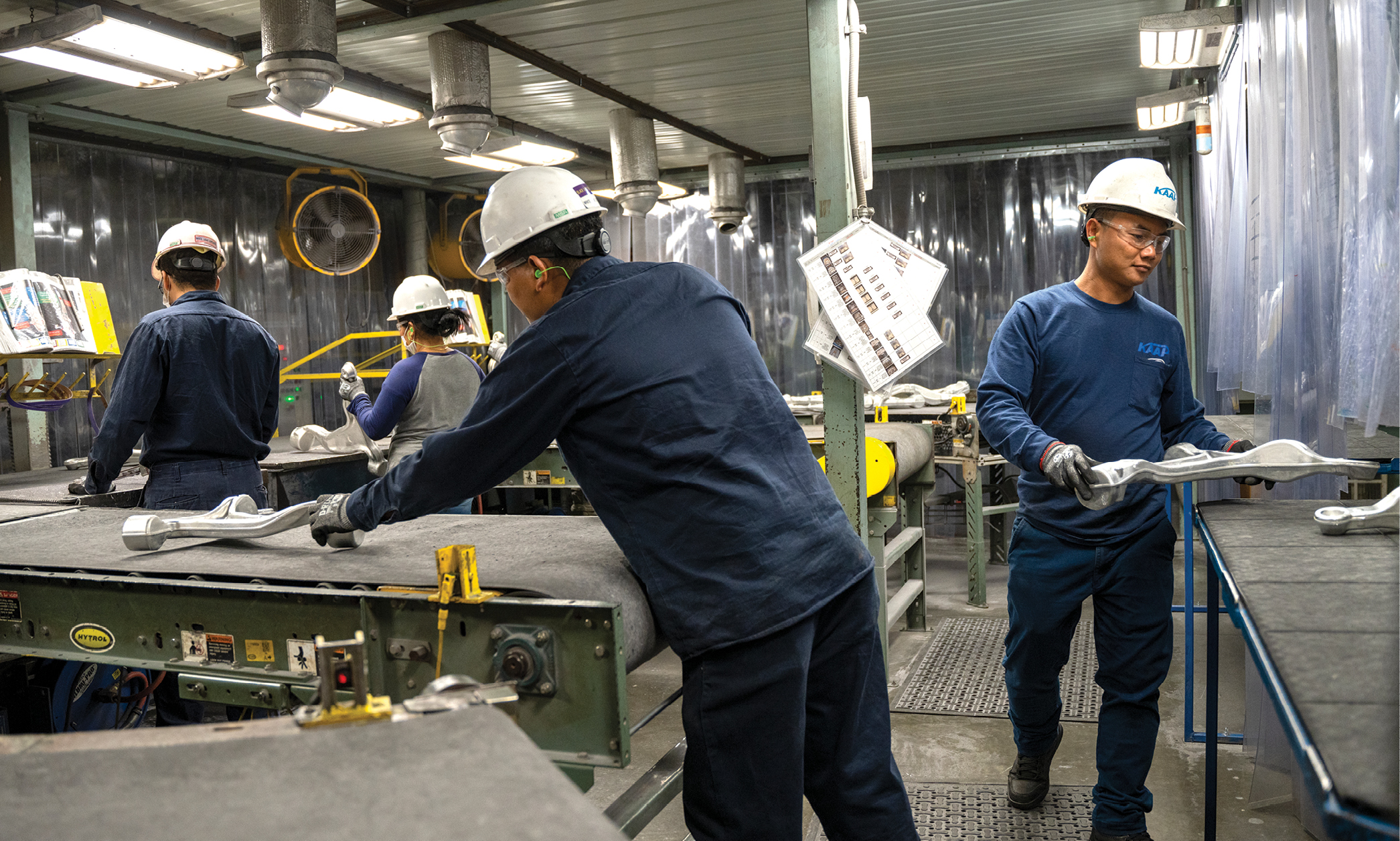While Kentucky has won multiple significant manufacturing investments over the last three years, the Bluegrass State’s prowess in this sector is certainly nothing new.
For decades, small businesses and industry giants alike have thrived in Kentucky, producing many of America’s most popular products. Post-it Notes, Pop-tarts, Hot Pockets, Airheads, Mentos, Tiffany engagement rings, GE appliances and a litany of other household staples and luxury goods are made in Kentucky.
Approximately 6,000 manufacturing facilities are located throughout the state, developing products for several key industries including automotive and EV, aerospace, distribution and logistics, metals, health care, food and beverage, agritech and more. These companies contribute $46 billion annually to the state’s gross domestic product and employ approximately 250,000 employees, 12.5% of the state’s workforce — nearly 4.5% higher than the national average, according to the National Association of Manufacturers.

Kentucky Aluminum Automotive Products manufactures lightweight aluminum parts in Bowling Green.
Photo courtesy of KAAP
This robust network of suppliers and global brands paired with the state’s low business costs, strategic location, logistics capabilities, skilled workforce, various incentive packages and resources such as the Kentucky Association of Manufacturers (KAM) has helped establish Kentucky as a national leader for manufacturing.
As the state’s central advocate for promoting economic growth through manufacturing, KAM has played a significant role in ushering in droves of investments that have taken Kentucky’s economy to the next level. In 2022, manufacturing brought $8.3 billion in new investments and over 8,900 new jobs, making up 79% of all corporate investments and almost 56% of job creation that year.
In 2023, 113 manufacturing projects were announced, totaling $3.7 billion in new investments, and creating approximately 5,800 full-time jobs. Significant projects from the last year include the expansion of Safran Landing Systems’ Boone County facility; Aerospace Composites Solutions’ (ACS, formerly known as Blackhawk Composites) $16.8 million relocation to Morgantown; Ahlstrom’s $68 million investment in Madisonville; a new $240 million manufacturing facility in Bowling Green from O-I Glass; and the grand opening of Nucor Corporation’s $1.7 billion steel plate manufacturing mill in Brandenberg.
“State leaders have demonstrated a commitment to making sure we have the necessary workforce talent, intentional planning and support of infrastructure and a regulatory environment centered on a partnership finding solutions.”
— Johnny Jacobs, Vice President & General Manager, Nucor Steel Brandenburg
“Our presence and growth in Kentucky are attributable to the positive business climate. Our state leaders have clearly recognized that manufacturing provides great careers and is critical to the overall economy,” said Johnny Jacobs, Nucor Steel Brandenburg vice president and general manager, in a press release. “State leaders have demonstrated a commitment to making sure we have the necessary workforce talent, intentional planning and support of infrastructure and a regulatory environment centered on a partnership finding solutions.”
Supply Kentucky
As Jacobs stated, Team Kentucky’s emphasis on fostering partnerships is integral to the state’s widespread success. Many of the incentives and unique resources available to Kentucky-based companies were built with this strategy in mind.
Incited by the state’s “Supply Kentucky” initiative to boost job growth, reduce costs and provide more security in the supply chains, KAM and the Kentucky Cabinet for Economic Development partnered in March 2023 to launch CONNEX Kentucky, a new online platform that provides a searchable supply chain database for Kentucky manufacturers. The free-to-register site links businesses with 140,000 local and national manufacturers, allowing companies to find Kentucky partners to satisfy their supply chain needs, increase reliability and decrease transportation costs.
“As we grow our state’s already incredible manufacturing presence, it is crucial we continue to provide companies in every corner of the state with the resources they need to support new good-paying jobs,” Gov. Beshear said in a press release. “This new statewide platform fills a critical void in that effort and ensures Kentucky will continue to meet the needs of growing companies. Thank you to the Kentucky Association of Manufacturers for their partnership in making the commonwealth the best place to do business.”
The platform provides and OEMs with the ability to:
- Quickly find the perfect qualified U.S. supplier;
- Access manufacturing-only data (no service providers);
- Post RFPs/RFQs/RFIs and send them to matching suppliers;
- View all U.S. supplier data in one location;
- Filter suppliers by location, certifications, SBA designations, materials, equipment, processes and more;
- Access blacklisted-supplier alerts;
- Use supply chain risk visualization; and
- Communicate with potential suppliers directly in the platform.
- Kentucky suppliers can use it to:
- Find ideal contracts with less effort;
- Receive RFPs/RFQs/RFIs directly from buyers (no broker listings);
- Find alternate sourcing for parts and materials;
- Discover new contract opportunities within new industries;
- Showcase all capabilities, certifications, SBA designations, equipment and more in one location for buyers to see; and
- Connect with and respond directly to OEM/PRIME buyers within the platform.
Supply Kentucky also coordinates marketing efforts, provides resources related to the workforce and connects Kentucky companies to suppliers throughout the country, as well as fosters the growth of minority- and female-owned businesses.
“Thanks to this important new partnership between the Kentucky Association of Manufacturers and the Kentucky Cabinet for Economic Development, Kentucky’s manufacturers and countless other companies will have access to one of the best tools in the marketplace to help grow their revenue, strengthen their supply chains and enhance the job security of their employees,” said Frank Jemley, president and CEO of KAM. “We are grateful to Governor Beshear, Secretary Jeff Noel and the great team at the Cabinet for Economic Development for this collaboration that will create new opportunities for the Kentuckians who make world-class products.”
Something Worth Celebrating
While the rest of America was carving pumpkins and hanging up Halloween decorations, Kentucky was celebrating an integral pillar of its economy: manufacturing.
Last October, Gov. Andy Beshear designated the 10th month of the year Manufacturing Month, honoring the sector that continues to be at the epicenter of the state’s unprecedented growth.
“Manufacturing Month offers all of us an opportunity to celebrate and thank the quarter-million Kentuckians at the 3,000-plus manufacturing companies around the commonwealth whose dedication and innovation are the reasons Kentucky has become a top location to make world-class products,” said Frank Jemley, president and CEO of the Kentucky Association of Manufacturers (KAM). “Through their hard work and creativity, those 250,000 Kentuckians are creating even more opportunities for the citizens of our great state, since manufacturing is the bedrock of every aspect of our economy and therefore every Kentucky community, big and small.”
“We could not have the tremendous economic success we’ve had these past three years if not for our expansive manufacturing network,” Gov. Beshear said last October. “From our diverse food and beverage industry to primary metals to the automotive and electric vehicle market that is reaching new heights every year, manufacturing is at the center of our recent success and that will continue to be true for decades to come. Thank you to every manufacturer creating great jobs for Kentuckians and distributing Kentucky-made products around the globe.”






